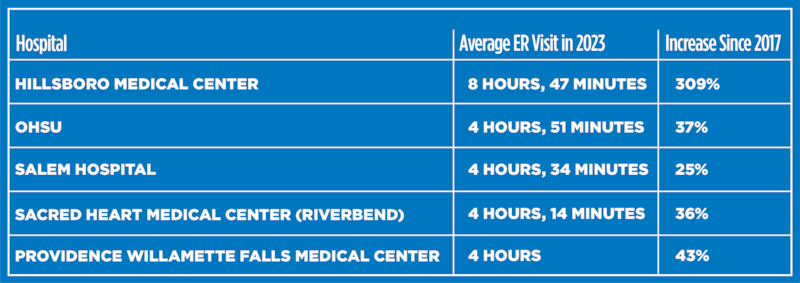The national average for an emergency room stay at “high volume” hospitals is around three and a half hours. Stay times at Oregon’s slowest ERs, including several in the Portland area, far surpass that. And the trend is only getting worse.
A WW analysis of the latest data from the federal Centers for Medicaid & Medicare Services found PeaceHealth’s RiverBend facility in Springfield and several hospitals affiliated with Oregon Health & Science University topped the list of slow ERs, all of which had gotten significantly worse in recent years.
The data, compiled by the federal regulator from a sample of patient records, come with a caveat: This isn’t a measure of wait times, but rather the total time patients spend in the ER before leaving—including sitting around in the waiting room.
Still, the agency warns that long stays are a possible sign of understaffing or overcrowding, and “may result in delays in treatment, increased suffering for those who wait.” (More recent numbers aren’t yet available, but representatives for the hospital systems say wait times have since fallen.)
The Oregon Nursing Association has been collecting patients’ horror stories since the closure of PeaceHealth’s Eugene hospital in late 2023 led to backups at nearby RiverBend.
“My mother waited 8 hours in the RiverBend ED. We talked to people in the waiting room who waited NINETEEN hours!” one person wrote in response to a September survey distributed by the union.
Adds Dr. Charlotte Yeomans, a hospitalist and union leader who is pushing for staffing increases: “The wait times are traumatic. They are fundamentally changing how our patients feel about the care they receive in the hospital.”
But the two worst hospitals in the state, according to WW’s analysis of 2023 data, are affiliated with OHSU: the system’s Pill Hill flagship and the Hillsboro outpost where it took over clinical care in 2016.
Representatives of both say they’ve implemented new strategies to reduce time spent in the ER. (One of those strategies, OHSU leaders said earlier this year, was sending patients to Hillsboro.)
Ultimately, they say, the problem comes down to simple math: Demand is increasing for a limited supply of beds.
“OHSU provides the most complex care available in the state,” says spokesman Erik Robinson. “Given the overall high demand, OHSU Hospital remains completely full.”


